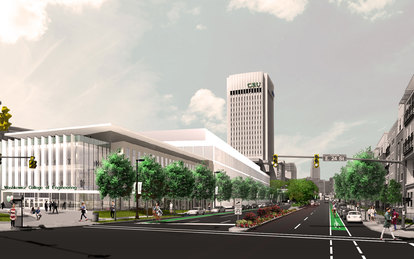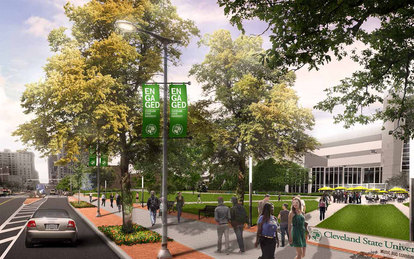Cleveland State University Master Plan
A 10-year master plan sets up strategies for a downtown campus to enhance connections with its urban community and expand opportunities for research and student success.
客户
Cleveland State University
位置
Cleveland, Ohio
市场/服务
Architecture, Campus Master Plans, Campus Placemaking, Campus Planning, Higher Education, Urban Environments
大小
85 AC
Cleveland State serves its 17,500 students on four campuses in Northeast Ohio, including its 90-acre main campus, a high-density urban setting in downtown Cleveland. Established in the 1960s with the intention of activating the city’s central core, the downtown campus as worked for decades to improve its accessibility and urban connectivity. In the 10-year master plan celebrating the institution’s 50-year anniversary, the university sought to build on its ongoing efforts to “re-urbanize” its downtown campus, making it more responsive to the needs of today’s students and the Cleveland community.
The master plan lays out strategies to ensure that the valuable downtown campus space is put to its highest and best use. It focuses on renovating core campus assets and explores how facilities can be repurposed for evolving teaching styles and research needs. The plan also emphasizes fiscal stability through programming partnerships, expanded residential housing, and other strategies. It builds a stronger on-campus student community that fosters student success and, at the same time, reconnects the campus with its urban neighborhood, bringing new benefits to both.

The plan was built on student retention, focusing on opportunities for academic growth and improved learning spaces to foster collaboration. To create a campus neighborhood, the plan also recommends a stronger Science Precinct and improvements to the adjacent athletic and residential spaces. The plan recommends renovating several academic classrooms into more technology-rich, flexible spaces for today’s active learning and proposes removing the outdated Chester Building to make way for a new interdisciplinary Engineering and Sciences Precinct, a field of growth for CSU.
The plan recommends repurposing 21-story Rhodes Tower, previously housing administrative functions, as a residential hall on its upper levels and library/gathering space below, creating a greater sense of campus life and community while also providing a new revenue stream. Recognizing the varied needs of students, the plan also recommends satellite academic facilities to increase access to education without long commutes.
The plan expands on the university’s past updates to activate campus streets and connections with its urban environment. It prioritizes pedestrian movement with The Innerlink, a connected system of indoor and outdoor walkways and collaboration zones. It enlivens the streetscape with entries re-oriented outward, ground-floor services and amenities, landscape plazas and a campus mall along Euclid Avenue. Visioning for Euclid Avenue, Cleveland State’s most recognizable street, includes the creation of a mixed-use quadrangle that offers a shared gateway between the city and campus. As implementation moves forward, Cleveland State continues to enhance its role as an integral partner in the downtown community and a regional economic engine.

